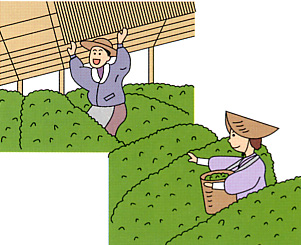There are two basic methods of harvesting (plucking) tea: handpicking (manual) and mechanical. The mechanical method in turn is conducted in two ways:
with a shearer held by two men walking on the sides of the tea rows or with
a power plucker set on two rails placed along the rows.
Depending on the intended use, the bud alone or the bud plus one or two
leaves are plucked.

Below is an estimated average of the quantities of raw leaves plucked with both mechanical methods and by handpicking. After the harvest, the raw leaves are immediately steamed, and on average it takes 5 kg of raw leaves to produce 1 kg of steamed tea.
| Power plucker: | 500 kg of raw leaves per day | |
| Hand shearer (by 2 persons): | 200 kg of raw leaves per day | |
| Handpicking (by 1 plucker): | 20 kg of raw leaves per day |
Undeniably, the mechanical methods are quicker and thus much more economical than the manual method. However, the mechanical plucking results in relatively
low quality products, for the harvest includes some foreign materials
like parts of the stems and dried leaves, which cannot be completely eliminated during the
separation.
Handpicking is costly, but it results in a much better quality product. It
allows for plucking the right portion of the shoot at the right
place, without inclusion of foreign materials. That is what makes handpicked teas more expensive than those
harvested
mechanically.
Nevertheless the power plucker (or rail plucker) gives harvests with considerably low stem contents, while it is
fast. Furthermore, it makes even cuts on the tea rows, contrary to the hand
shearer. For this reason it is considered as the most economical and quality-oriented plucking method.